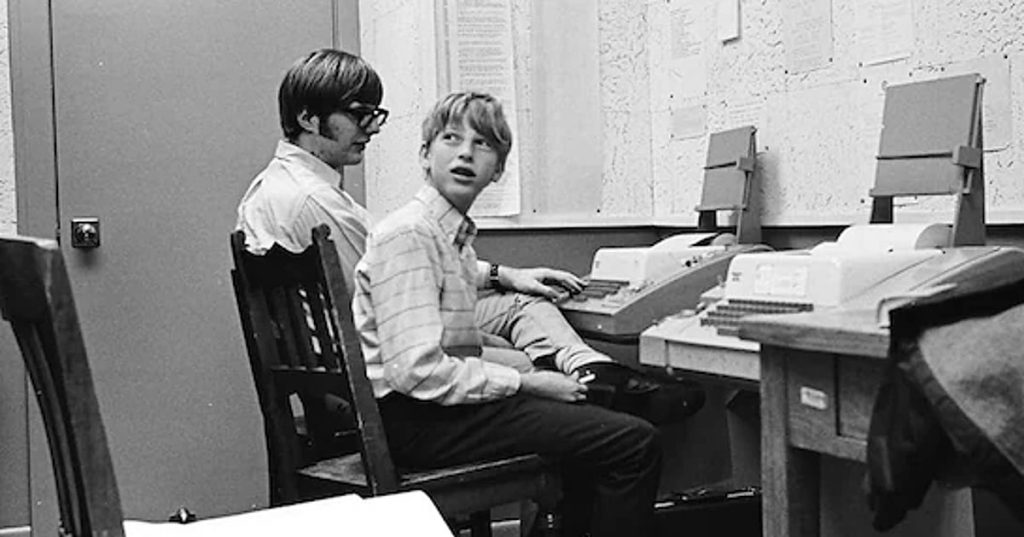In 1997, Microsoft even went so far as to save Apple from bankruptcy by investing $150 million in its capital in the form of non-voting shares, which were sold back three years later. During one of his famous keynote speeches, Steve Jobs thanked Bill Gates by saying: “Bill, thank you. The world’s a better place.” This bailout also put an end to the lawsuit Apple had filed against Microsoft, accusing it of copying its graphic interface when designing the Windows operating system.
Third era: bureaucratization, internal conflicts and a failed diversification strategy
In the mid-1990s, computing underwent a new transformation with the explosion of the World Wide Web. Microsoft was a specialist in stand-alone PCs, with a business model based on selling boxed software, and it was ill-prepared for the new global networks. Its first response was to develop Internet Explorer, a browser developed from the takeover of the Mosaic browser designed by the Spyglass company, a bit like MS-DOS in its day. Internet Explorer was eventually integrated into Windows, prompting a lawsuit against Microsoft for abuse of its dominant position, which could have led to the company’s break-up. New competitors, such as Google with its Chrome browser, took advantage of these developments to attract users.
In 2000, Bill Gates handed over his position as Microsoft CEO to Steve Ballmer, one of his former Harvard classmates, whose aim was to turn the company into an electronics and services company. Over the next fifteen years, Ballmer embarked on a series of initiatives to diversify the company by including video games (Flight Simulator), CD encyclopedias (Encarta), hardware (mice, keyboards), MP3 players (Zune), online web hosting (Azure), game consoles (Xbox), phones (Windows Phone), tablets and computers (Surface).
While some of these products were successful (notably Azure and Xbox), others were bitter failures. Encarta was quickly swamped by Wikipedia and Zune was no match for Apple’s iPod. Windows Phone remains one of the greatest strategic blunders in the company’s history. In order to secure the company’s success in mobile telephony and compete with the iPhone, Microsoft bought the cell phone division of Finland’s Nokia for $5.4 billion in September 2013. The resulting integration was a disaster: Steve Ballmer wanted Microsoft’s phones to use a version of Windows 10, making them slow and impractical. Less than two years later, Microsoft put an end to its mobile phone operations, with losses amounting to $7.6 billion. Nokia was sold for just $350 million.
One of the outcomes of Microsoft’s multiple business initiatives has been an explosion in the number of its employees, from 61,000 in 2005 to 228,000 in 2024. Numerous internal disputes broke out between different business units, which sometimes refused to work together.
These turf wars, coupled with pervasive bureaucratization and effortless profitability (for each Windows installation, PC manufacturers pay around $50, while the marginal cost of the license is virtually zero), have hindered Microsoft’s capacity for innovation. Its software, including Internet Explorer 6 and Windows Vista, was soon mocked by users for its imperfections, which were continually plugged by frequent updates. As some people noted, Windows is equipped with a “safe” mode, suggesting that its normal mode is “failure”.
Fourth era: is Microsoft the new cool (thanks to the Cloud and OpenAI)?
In 2014, Satya Nadella replaced Steve Ballmer as head of Microsoft. Coming from the online services division, Nadella’s objective was to redirect Microsoft’s strategy online, notably by developing the Azure online web hosting business. In 2024, Azure became the world’s second-largest cloud service behind Amazon Web Services, and more than 56% of Microsoft’s turnover came from its online services. Nadella changed the company’s business model: software is no longer sold but available on a subscription basis, in the shape of products such as Office 365 and Xbox Live.
Along the way, Microsoft acquired the online game Minecraft, followed by the professional social network LinkedIn, in 2016, for $26.2 billion (its largest acquisition to date), and the online development platform GitHub in 2018 for $7.5 billion.
Between 2023 and 2025, Microsoft invested more than $14 billion in OpenAI, the company behind ChatGPT, giving it a particularly enviable position in the artificial intelligence revolution. ChatGPT’s models also contribute to Microsoft’s in-house AI, Copilot.
Over the past 50 years, thanks to a series of bold moves, timely acquisitions and failed strategies to diversify, Microsoft has evolved significantly in its scope, competitive advantage and business model. Once stifled by opulence and internal conflicts, the company seems to have become attractive again, most notably to young graduates. Who can predict whether Microsoft will still exist in 50 years? Bill Gates himself says the opposite, but he may be bluffing.
This article is republished from The Conversation under a Creative Commons license. Read the original article here.

